
PO Box 9021, Wilmington, DE 19809, USA
E-mail: tours@focusonnature.com
Phone: Toll-free in USA, Canada, & Puerto Rico 1-800-721-9986
or 302/529-1876

PO Box 9021, Wilmington, DE
19809, USA
E-mail: tours@focusonnature.com
Phone: Toll-free in USA, Canada, & Puerto Rico 1-800-721-9986
or 302/529-1876
HIGHLIGHTS
FROM FOCUS ON NATURE TOURS in 2011
DURING
BIRDING & NATURE TOURS IN: ANTIGUA,
BARBUDA, BELIZE, BRAZIL (2 tours), CHILE, COSTA RICA, DOMINICA, GUADELOUPE, ICELAND, & JAPAN.
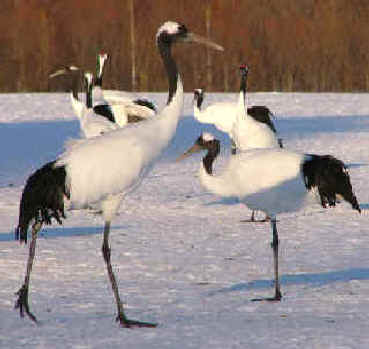
Again, on the snow, during
our January 2011 Japan Tour.
there were Red-crowned, or Japanese, Cranes,
known as "Tanchos".
The tour summaries here are given with the most-recent tours first.
![]() For
some tours there are links below for longer NARRATIVES. Also there
are links to UPCOMING TOUR ITINERARIES, and LISTS relating to BIRDS,
MAMMALS, & OTHER NATURE.
For
some tours there are links below for longer NARRATIVES. Also there
are links to UPCOMING TOUR ITINERARIES, and LISTS relating to BIRDS,
MAMMALS, & OTHER NATURE.
Links to Tours:
BRAZIL
(May 2011)
BELIZE (April 2011)
LESSER ANTILLES (February 2011)
![]()
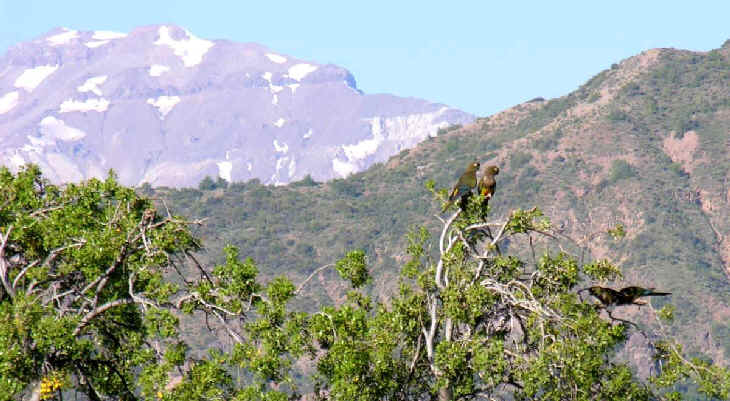
Chilean countryside in the
foothills of the Andes,
with 2 rare Burrowing Parrots perched in a treetop,
photographed during the November 2011 FONT tour
(photo by Frank Stermitz)
Chile
- November 2011
Among the birds that were enjoyed during our November
2011 tour in Chile, from the Andes
Mountains to the Pacific Ocean,
and from Santiago south to Chiloe Island,
were these:
Andean Condors, Burrowing and
Slender-billed Parakeets, Humboldt and
Magellanic Penguins, Gray-breasted Seedsnipes, the Many-colored Rush
Tyrant, the Austral Negrito, the Crag Chilia, Snowy-crowned Terns,
Great Grebes, Kelp Geese, the Flightless Steamer Duck, and Black-necked
Swans, with cygnets riding on their backs.
We saw 3 species of oystercatchers and 4 species of
cormorants, including the most beautiful of the latter, the Red-legged
Cormorant.
Among the mammals were a Kodkod (a wild cat), a Pudu (a
wild deer), a Grison, an Akodont (a vole-like South American
mouse), and the Marine Otter or Chungungo (a close relative of the
Sea Otter of the Northern Hemisphere).
Links:
More about the FONT Chile Tour in November 2011
A Gallery of Photos from our November 2011 Chile Tour
List
of Birds & Other Wildlife during the FONT Chile Tour - November 2011
Some
Highlights from Previous FONT Chile Tours
A List & Photo Gallery of Chile Birds, in 2 parts:
Part #1: Tinamous to Coots
Part #2: Thick-knee to Saltator
Mammals of Chile (with some photos)
Butterflies & Moths in Chile (with some photos)
Amphibians & Reptiles in Chile (with some photos)
The Diverse Plant-life of Chile (with some photos)
Upcoming
FONT Birding & Nature Tours in Chile
![]()

Iguazu Falls
Our August 2011 tour in Brazil was at Iguazu
Falls and in the state of Mato Grosso do Sul,
including the Pantanal, a region known for
its wonderful wildlife, with large concentrations of birds, along with mammals
and other nature.
It was the 50th FONT tour in Brazil, since 1991.
Over the years, we've dubbed this as our "Jabiru & Jaguar
Tour". Seeing the Jabiru is
easy. But seeing the Jaguar is not.
Among the Jabirus that we saw in August 2011
were 2 parents with 2 young birds on a big nest high in a tree. After flying in,
one of the parents fed both of the two hungry youngsters.
We've seen Jaguar during 4 of our previous Brazilian tours in
Mato Grosso do Sul, once, prior to this tour, during the day,
and 3 times previously at night.
During the morning of August 10, 2011, at about 10 o'clock
we had another daytime Jaguar sighting. It was by a channel
of water, at a concrete covert, for just a short while, before disappearing into
the covert and probably out the other side.
We travel about in that area on high, open vehicles. The previous night, in such
a vehicle, we enjoyed a great look at an Ocelot, after seeing 3 Giant
Anteaters, Crab-eating Foxes, Marsh Deer, 6-banded or Yellow
Armadillos, Capybaras, and Caiman. In all, there were 18
species of mammals during the tour, not including any bats.
Also as we traveled about that night, we saw 3 species of
nightjars, and heard another.
Among the numerous birds during the tour were the Jabirus (the
largest American stork), the Hyacinth Macaw (the largest parrot in
the world), the Greater Rhea (the largest American bird), and the Toco
Toucan (the largest toucan). In all, well over 200 species of birds.
Raptors during the tour included: Aplomado Falcon, Snail Kite
(hundreds of them), Crane Hawk (seen exceptionally well), Great Black
Hawk, Savanna Hawk, Crowned Solitary Eagle, Black-chested
Buzzard-Eagle, White-tailed Hawk, and Black-collared Hawk
among others.
Parrots during the tour, in addition to the Hyacinth Macaw,
included: Blue-and-yellow Macaw, Red-and-green Macaw (a good
number enjoyed especially at a large limestone sinkhole), Golden-collared
Macaw, White-eyed Parakeet, Peach-fronted Parakeet, the Nanday,
or Black-hooded Parakeet, Reddish-bellied Parakeet, Blaze-winged
Parakeet, Monk Parakeet, Blue-winged Parrotlet, Yellow-chevroned
Parakeet, Scaly-headed Parrot, and Turquoise-fronted and Orange-winged
Amazons.
Another bird that we saw nicely during this Brazilian tour is in the photo
below. Name it rightly, and you're entitled to a 10 per cent discount on any
future FONT tour.
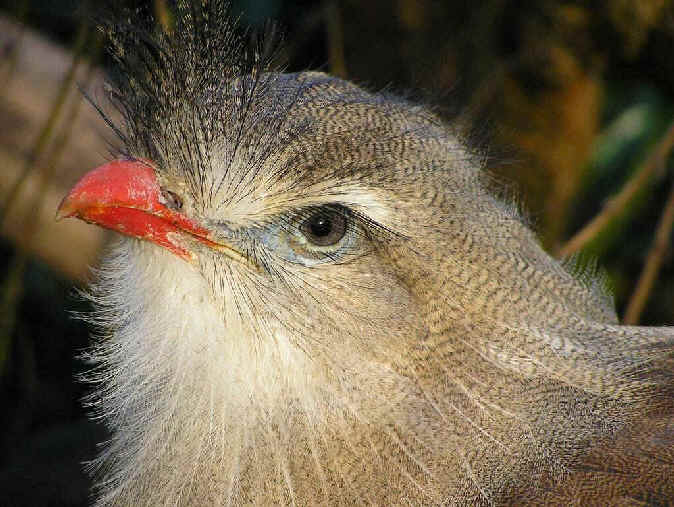
The area of Iguazu Falls was particularly good for butterflies, as it has
been during FONT tours in the past. A good number of about 3 dozen species
were seen, including various crackers, leafwings, longwings,
sisters, swallowtails, the Red Rim (Biblis hyperia), and a few species of
"88s" in the Diaethria and Callicore genera.
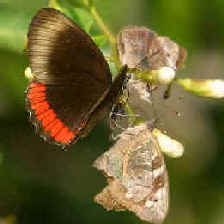
Red Rim
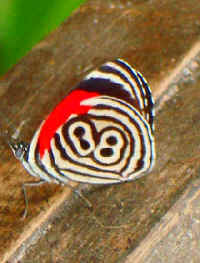
Eighty-eight Butterfly,
Diaethria clymena
Links:
List
of Birds & Other Wildlife during the FONT Brazil Tour - August 2011
A
Complete List of Brazil Birds, noting those during previous FONT tours, in 3
parts:
Part #1: Tinamous to Doves
Part #2: Macaws to Flycatchers
Part #3: Antshrikes to Grosbeaks
Rare Birds during FONT Tours in Brazil (with some photos)
Mammals & Some Other Wildlife during FONT Brazil Tours (with some photos)
Butterflies in Brazil, and especially at Iguazu Falls
Upcoming FONT Birding & Nature Tours in Brazil
![]()
Iceland - June 2011
Our Iceland tour in June 2011
was the 55th FONT tour in Europe, and our 17th tour in Iceland, where
we've conducted birding and nature tours during both
the late-spring and the early-fall.
On one afternoon during the tour, we were along the
northern Icelandic coast, right by the Greenland
Sea.
In a small pool there, of cold water, a pair of little Red-necked Phalaropes,
about 7 inches in length, were spinning around and flitting about.
In the next small pool to the right, there was warmer water, and in it a pair of
people, an Icelandic couple, enjoying the geothermal heat.
To the right, closer to the very cold sea, there was a warmer pool yet. It was that
small pool of hot water that those in our group, who took a dip, enjoyed the
most.
That duo of dapper little Red-necked Phalaropes would be there for only a
relatively short time, just a few weeks to nest and raise their young. Then,
they would fly away, to go to the ocean where they would winter by the Arabian
Peninsula.
In the warm geothermal pools, we would be for just a short while, before a few
days later, heading back to places such as Atlanta and Los Angeles.
But it was another creature in the area that would be traveling the furthest.
After the Icelandic couple lifted out of the pool, they walked north along the
nearby coastline, where, from the stones, a mass of shrieking Arctic Terns
rose into the sky. That cloud of birds circled about loudly overhead. They were
nesting among those stones, and when their breeding season would finish, later
in the summer, they would fly away, but to go further than any bird on Earth,
traveling over the ocean south rounding the southern tip of Africa and
continuing east into the Indian Ocean.
Offshore from the stony coast, there was a rocky islet rising abruptly from the
sea. On it, out there, a pair of Gyrfalcons was nesting, and there were
breeding Atlantic Puffins atop the cliffs and sitting on the adjacent
sea. Those oceanic waters were also the haunts of creatures such as the Greenland
Shark, other fish, the Harbor Seal, and various whales and dolphins.
Described here was just one of the places that we visited during our tour. To
read about others, and for more interesting information about the Atlantic
Puffins in Iceland, please click the link below for "More about the
FONT Iceland Tour in June 2011".

The Atlantic Puffin was seen
during the FONT June 2011 Tour in Iceland
Links:
More about the FONT Iceland
Tour in June 2011
List of Birds during our Iceland Tour - June 2011
Birds during previous FONT Iceland Tours
Complete
Iceland Bird-List
(383 species, including vagrants from mainland Europe, Asia, & North America)
Wildflowers
of Iceland (with some photos)
Upcoming FONT Birding & Nature Tours in Iceland
![]()
Brazil
(Southeast & Minas Gerais) - May 2011
Our Brazil tour in May 2011 came to be as a result of the earthquake and related problems in Japan a couple months earlier. We normally have gone to Japan in May. But instead, in Brazil, we went to the southeast part of the country, including the more-inland area of Minas Gerais.
During the tour,
much of the nature we observed were birds.
And there were some
nice butterflies.
But, particularly interesting were mammals,
including the largest of the
monkeys in the New World, an animal known as the Muriqui.
It was the Northern Muriqui
that we saw, notable not just for being the biggest,
but for being one of the rarest mammals in the world. The Muriquis
are nearly 5 feet tall, and the total population of the species is about
500 individuals. We were fortunate to see a group of them well, in a fine
forest that has been preserved because it has been their home.
There are, in all, about a hundred species of monkeys known to be in Brazil. But among them, the Muriqui is special. It has been written that, as a conservation symbol, the Muriqui is for Brazil as the Giant Panda is for China.
Other mammals during the tour included 5 other species of monkeys: Brown Howler (the rarest of the howlers), Black Tufted Capuchin, Masked Titi, Buffy-headed Marmoset, and Buffy-tufted Marmoset. Also seen during the tour was the Maned Wolf.
Among the nearly 300 species
of birds, some of the most notable were: Black Hawk-Eagle,
Black-bellied Thorntail, Hyacinth Visoprbearer (two of the numerous
hummingbirds during the tour),
Three-toed Jacamar, Robust
Woodpecker, Pin-tailed Manakin, Sharpbill, Swallow-tailed
Cotinga, Red-ruffed Fruitcrow, Streamer-tailed Tyrant, Cipo Canastero, Black-billed
Scythebill, Forbes's Blackbird (one
of the rarest birds in Brazil), Campo Troupial, and Black-masked Finch.
These were in addition
to a good assortment of tanagers, toucans, trogons, and other birds
of the Neotropics.
As was the Swallow-tailed Cotinga, among the birds just mentioned, the
male Pin-tailed Manakin was
truly a favorite, with its colorful plumage of red, black, white, and green, in
addition to its orange eyes. Other Manakins were
also seen well and enjoyed during the tour: the Blue, and the White-bearded.
Relating to the birds, the manakins alone made Brazil a nice place to be in May, but of course the tour was so much more with the Muriquis.
Links:
More about the May 2011 FONT Tour in Brazil
A Gallery of Photos from our May 2011 Brazil Tour
List
of Birds & Other Wildlife during the FONT Brazil Tour - May 2011
A
Complete List of Brazil Birds, noting those during previous FONT tours, in 3
parts:
Part #1: Tinamous to Doves
Part #2: Macaws to Flycatchers
Part #3: Antshrikes to Grosbeaks
Rare Birds during FONT Tours in Brazil (with some photos)
Mammals & Some Other Wildlife during FONT Brazil Tours (with some photos)
Upcoming FONT Birding & Nature Tours in Brazil
![]()
Belize - April 2011
During the FONT
tour in Belize in April 2011, a wide range of wildlife
was seen, from manatees to manakins,
from large to little.
We went to some wonderful places, from "Crooked
Tree" to "Cotton Tree".
Also to places with names such as Gales Point
and Banana Bank.
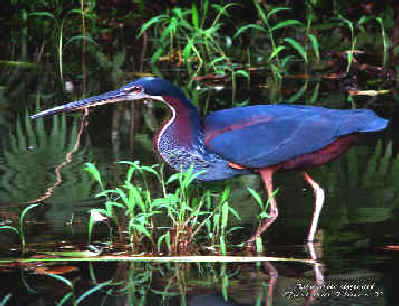
Agami Heron
Among the birds that we saw were there were about 50 Jabirus and
an Agami Heron. And many more, from "A" to "Z",
from that Agami to a Xenops.
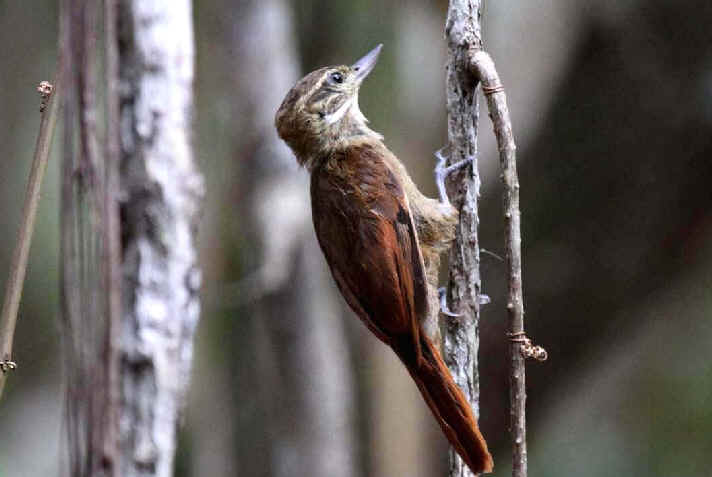
A Plain Xenops at Crooked Tree
during the April 2011 FONT Belize Tour
Links:
More about the FONT Belize Tour in April 2011
A Feature of Photos from the April 2011 FONT Belize Tour
A
List of Birds & Other Wildlife during our Belize Tour in April 2011
A Cumulative List of Birds in Belize
Upcoming FONT Birding & Nature Tours in Belize
![]()
Lesser
Antilles (Antigua, Barbuda, Dominica, Guadeloupe)
- February 2011
During the FONT Caribbean tour in February
2011, there were two West Indian endemic birds that are not often
seen: the Barbuda Warbler and the Guadeloupe Woodpecker.
To see them, a special effort must be made. They occur on only those single
islands of Barbuda and Guadeloupe, and one must go to where they are.
Barbuda is a very small island, with only 48
square miles. It is about 30 miles north of the island of Antigua in the Leeward
Islands.
Until the beginning of this century (in 2000), the Barbuda Warbler was
called the Adelaide's Warbler which was, up to that time, said to have 3
geographically distinct populations: one in the more arid part of Puerto Rico,
one on the Lesser Antillean island of Saint Lucia, and one in between (but not
near either of the others) on the little island of Barbuda. Now, each of the
three populations are separate, and isolated, species.
Further south in the Caribbean, Guadeloupe
is one of the Windward Islands, and one of the French Antilles. Thus, the
Guadeloupe Woodpecker, endemic to that island, has a French name: "Tapeur".
Another bird seen during our Feb '11 tour on Guadeloupe, and also on Dominica,
was the Plumbeous Warbler, a bird that only occurs on those two
islands. Also seen on Dominica were the Imperial Amazon and the Red-necked
Amazon (both of those parrots endemic to Dominica), the Blue-headed Hummingbird
(which only occurs on Dominica and to the south on Martinique), and a bird with
an odd habit, the Brown Trembler. That habit is, yes, that it trembles,
shaking its wings.
The island of Guadeloupe, from high in the
air, or on a map, has the shape of a butterfly. Among the butterflies that we
saw on that picturesque island, in addition to the common Whites, Yellows,
and Blues, there was a beauty called the Red Rim, Biblius hyperia, and
some of the local population of Monarchs, Danaus plexippus.
In all, we encountered over 60 species of birds during our time in February 2011
in the Lesser Antilles, with over 30 species on both Guadeloupe and Barbuda, and
nearly 30 species on Dominica. Most of these birds were either specialties or
endemics of the Caribbean.
Links:
More
about the FONT Lesser Antilles Tour in February 2011
Birds & Other Wildlife during our Lesser Antilles Tour - February 2011
Cumulative
List of Birds during FONT Tours in the Lesser Antilles
A Bird-List & Photo Gallery of Caribbean Birds (in 2
parts)
Mammals & Other Wildlife of the West Indies (with photos)
Butterflies of the West Indies (with photos)
Amphibians & Reptiles of the West Indies (with photos)
Upcoming FONT Birding & Nature Tours in the West Indies
![]()
Costa
Rica - February 2011
In February 2011, it was our 30th FONT tour
in Costa Rica, in mostly the highlands of
the country.
During that tour, there were about 300 species of birds (303), as
well as mammals, butterflies, and other nature.
Among the birds during the tour: Resplendent Quetzal, Three-wattled Bellbird,
Turquoise Cotinga, and Scarlet Macaw were seen. One of the remarkable
aspects of our Feb '11 tour in Costa Rica was that with each of these species. both the male and the female birds were nicely seen.
As to the first three, there are distinctive differences between the sexes. The
male and female Scarlet Macaws appear the same, but that species
normally occurs in male-female pairs. We saw, closely, about a dozen Scarlet
Macaws one afternoon, in flight, and feeding in trees atop rocky cliffs by
the Pacific Ocean.
The female bellbird and cotinga are not seen as often as the
males. Our encounter with the bellbird was with a pair in a forest, at
times next to each other on a branch, as the male repeatedly gave its loud
call.
At times, the brilliantly blue male Turquoise Cotinga perches in the open
on a bare branch at the top of a tree, but we saw first the female cotinga,
in such a way, before we saw the male.
And with the quetzal we also saw the female before the male. A female came to a small fruit tree,
in the middle of a field, to
eat. A short while later, we saw a male, with its colorful plumage shining in the morning
sunlight, as it sat ever so
still at the forest edge. As always, it was wonderful to see that
spectacular species.
Other notable birds during the tour included: Southern Lapwing, White Hawk,
Chiriqui Quail-Dove, Buffy Tuftedcheek, Black-breasted Coquette, and an
array of other hummingbirds, and an assortment of colorful tanagers
and their allies.
Mammals during the tour included 3 species of monkeys, Three-toed
Sloth, and
agoutis, coatis, and an animal called an Olingo.
Links:
More about the FONT Costa Rica Tour in February 2011
Lists of Birds & Other Wildlife during the FONT Costa Rica tours - February 2011
Costa Rica Birds (a list of 864 bird species; about 700 found during FONT tours)
A Photographic Sampling of Colorful Costa Rican Birds
A
Feature about Alexander Skutch, a naturalist in Costa Rica
Upcoming FONT Birding & Nature Tours in Central America
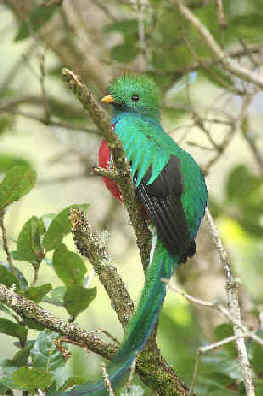
Among the highlights of the
February 2011 FONT Costa Rica Tour
were Resplendent Quetzal (above),
and Scarlet Macaw (below).
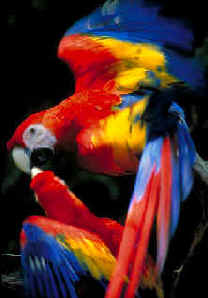
![]()
The FONT Japan Winter Birding
& Nature Tour in January 2011 was our 35th tour
in that country. During that tour, we visited the 3 Japanese islands of
Honshu, Hokkaido, and Kyushu.
In all, 125 species of birds were found: 76 on Honshu, 66 on Kyushu, and 49
on Hokkaido.
Although in Hokkaido there was
the lowest number of bird species, it was that
island, again, with the most highlights, including cranes, eagles, and the
Blakiston's Fish Owl.
The
Red-crowned Cranes were observed one nice afternoon, as they stood, danced,
and called on the snow.
At one time by the sea in eastern Hokkaido, we were surrounded by dozens of
eagles, both the White-Tailed and
magnificent Steller's, as hundreds of gulls,
mostly Glaucous, also foraged in the same area.
A fine flock of Asian
Rosy Finches was on the ground nearby.
Later
as that afternoon turned to night, we saw 2 huge Blakiston's Fish
Owls.
One of those big birds flew directly over our heads.
Hokkaido also had other notable birds for us in January 2011, including a
Japanese Accentor, both Bohemian
and Japanese Waxwings, an American Wigeon among
Eurasian Wigeon, Falcated Duck, Smew, many Harlequins and other Ducks,
a flock of Lapland Buntings or Longspurs, and some beautiful Bullfinches
of the gray-bellied race.
The Japanese Accentor is a most unusual bird in Hokkaido in the winter.
The Lapland Longspurs were a new
bird for the 35 FONT Japan tours, bringing our
cumulative total of species to 393.
In January
2011, we did pelagic
trips onboard ferries both to and from
Hokkaido.
During the northbound boat-trip to Hokkaido, we saw Laysan Albatross, numerous
Kittiwakes, other gulls, and alcids.
During
the southbound boat-trip, there were Japanese Murrelet, Common
Murre,
Red Phalarope, Streaked Shearwater, Pomarine Jaeger, Northern
Fulmar,
and various gulls, Pacific Loon, and Pelagic Shag.
In Kyushu during the
winter of 2010-2011, a sad note is that bird flu struck
in the flock of thousands of cranes that come to winter from mainland
Asia. So therefore, entry was restricted to the area of those cranes,
mostly Hooded and White-naped. Even so, we saw those species well,
along with both of the other rarer crane species there when we were there,
the Common and Sandhill Cranes.
Of course, the Common Crane is not
at all common in Japan.
The Sandhill Crane
is the most common crane in the world, with most in North America, but
some breed in Asia in Siberia. In January 2011, we saw 3 Sandhill
Cranes
in Kyushu.
The Hooded is the most common of
Kyushu's Cranes, with generally about 9,000.
The White-naped Crane is beautiful bird, graceful for sure. Generally
from about 1,500 to 2,000 of them winter on Kyushu.
Before we arrived in Japan,
about a half-dozen Hooded Cranes and a White-naped
Crane had died from the bird flu. Both species are classified as "vulnerable",
even without the flu problem, so let's hope that their situation relating
to that disease improves.
The cranes leave their limited
wintering range in Japan in February to return
to their expansive breeding range in China and Russia.
Other birds that we saw in Kyushu included, in reeds, the rare Pallas's 'Reed Bunting from Asia along with the Common Reed Bunting, which is common, as well as a White's Ground Thrush foraging in leaf litter, and a large flock of Common Shelducks, common at least at that one place.
Other notables during the tour were Mandarin Ducks, always nice to see, as were Japanese Grosbeaks, Hawfinches, Common Kingfisher, Brown Dipper, Azure-winged Magpie, the Japanese Green Woodpecker, Varied Tit, Red-flanked Bluetails, and Daurian Redstarts. As noted earlier, 125 bird species in all.
There were 7 species of mammals
during the tour including: the Japanese Macaque
(or Snow Monkey), Red Fox, Sika Deer, Northern Fur Seal, Kurile
Seal,
and, again for us, a second time, Sea Otter. Our other time for that rare animal
in Japan was the previous January, in 2010.
In Hokkaido, where we found our least number of bird species, there was for
us the most species of mammals.
And of course, as already said,
it was in Hokkaido where we experienced the true
avian highlights, including the cranes, swans and ducks, alcids,
eagles,
and what is said to be the largest and rarest owl in the world.
Links:
Birds & Other Wildlife during FONT Japan Tour in January 2011
A List
& Photo Gallery of Japanese Birds, in 2 Parts:
Part
#1: Pheasants to Pittas
Part #2:
Minivets to Buntings
Rare Birds during FONT Tours in Japan
Upcoming FONT Birding & Nature Tours in Japan

During the FONT Japan Tour in
January 2011,
a Sea Otter, known as Rakko in Japanese,
was seen
from shore in eastern Hokkaido.
The Sea Otter is very rare in Japan.
Only a few dozen are said to exist
in the nearby islands
that are part of Russia.
![]()